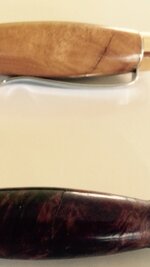AFTACP
Member
Attached is a pic of two cigar pens I finished roughly 3 weeks ago. They are unstabilized Yellow Box Burl and Vasticola Burl. They have not moved from a 70 degree room and have remained on an acrylic pen stand (no drops). These cracks were not at all visible during or after turning the pen.
I have read a bit on here about possible reasons (humidity, coefficient of expansion). I've had these blanks for over a year in the same 70 degree environment with not much change in the humidity. I know the blanks being unstabilized doesn't help but these cracks just appeared out of nowhere. Any help would be greatly appreciated to help avoid this in the future.
I have read a bit on here about possible reasons (humidity, coefficient of expansion). I've had these blanks for over a year in the same 70 degree environment with not much change in the humidity. I know the blanks being unstabilized doesn't help but these cracks just appeared out of nowhere. Any help would be greatly appreciated to help avoid this in the future.

